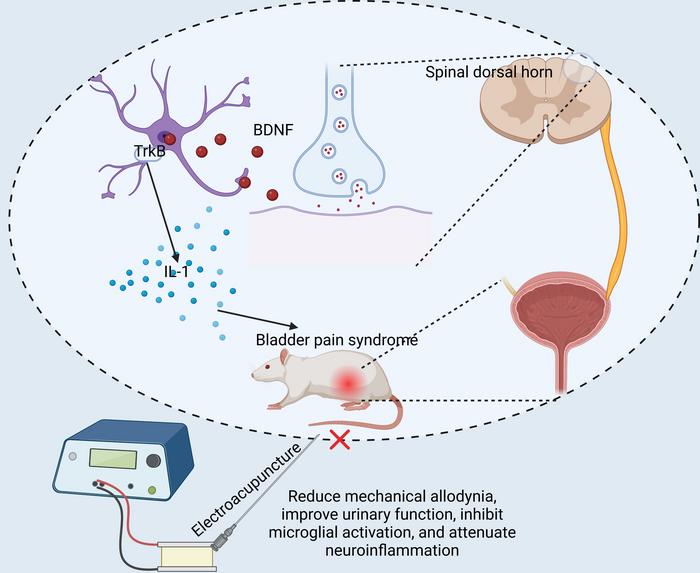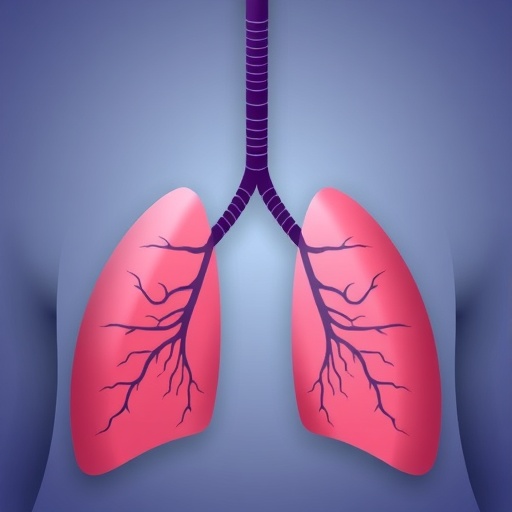
Electroacupuncture, an innovative therapeutic technique, is gaining attention as a potential treatment for a range of chronic pain conditions, including bladder pain syndrome, also known as interstitial cystitis. This often debilitating condition significantly affects patients’ quality of life, yet continues to be understudied and underrepresented in clinical treatment strategies. In an exciting development, researchers from Sun Yat-sen University, led by Min-Zhi Su, have embarked on a pioneering study to investigate the efficacy of electroacupuncture nerve stimulation therapy as a means to alleviate symptoms associated with bladder pain syndrome.
Within the extensively researched framework of pain management, traditional methods primarily focus on pharmacological interventions, often yielding limited success and accompanied by undesirable side effects. The study published in the esteemed journal eNeuro highlights the novel application of electroacupuncture, utilizing the rat model of bladder pain syndrome to uncover its potential benefits in alleviating chronic pain and enhancing bladder function. This approach is particularly noteworthy as it departs from conventional medical paradigms by incorporating alternative therapeutic techniques.
The findings from Su and colleagues reveal promising results, indicating that electroacupuncture may not only reduce neuropathic pain but also promote urinary function and mitigate neuroinflammation. Neuroinflammation is known to contribute significantly to the sensations of pain and discomfort associated with bladder pain syndrome. The research identified a mechanism by which electroacupuncture may exert its effects, focusing on the BDNF-TrKB signaling pathway in the spinal dorsal horn. This pathway plays a pivotal role in neural signaling and pain modulation, positioning electroacupuncture as a compelling therapeutic strategy that warrants further exploration.
Understanding the underlying mechanisms involved in electroacupuncture’s efficacy is crucial for its potential application in clinical settings. Previous studies have demonstrated that electroacupuncture can alter neural pathways in ways that support pain relief and enhance overall neurological health. The ability to directly influence the BDNF-TrKB pathway may open new avenues for treating painful conditions that have historically been resistant to treatment. By establishing this connection, the researchers have paved the way for broader investigations into how electroacupuncture can be utilized to manage not only bladder pain syndrome but also other chronic pain conditions.
The investigation signifies a critical shift in the perception of alternative medicine within the scientific community. Increasingly, researchers are exploring the synergy between traditional practices and modern medical methodologies. The results of this study stand as a testament to the potential integration of electroacupuncture into mainstream treatment protocols. However, the authors emphasize the need for further research, particularly in more advanced animal models and subsequent human trials, to establish the clinical applicability and long-term effectiveness of this treatment.
Moreover, this research is part of a broader trend emphasizing personalized medicine and the development of patient-centered approaches in pain management. As the medical community recognizes the complexity of chronic pain syndromes, the integration of electroacupuncture could offer a multidisciplinary angle to treatment. This perspective aligns with the goals of improving patient outcomes and minimizing reliance on conventional pharmacological remedies that may produce adverse effects.
What adds an interesting dimension to this research is its grounding in scientific rigor. The study is backed by the National Natural Science Foundation of China, ensuring that the researchers had the necessary support to conduct detailed experiments and analyses. As the findings are made public, they underscore the importance of funding in advancing scientific inquiries, especially when exploring the efficacy of alternative treatment modalities.
As more patients seek holistic and integrative approaches to health, the findings from this study could resonate widely. An increasing number of individuals experiencing chronic pain are turning to alternative therapies that promise fewer side effects and a more natural approach to recovery. The compelling evidence presented by Su and colleagues could lead to a paradigm shift in how bladder pain syndrome is managed, affording patients a new hope in their journey toward wellness.
This study illustrates the necessity for continued dialogue between traditional medicine practices and contemporary scientific research. Achieving balance in these areas could not only enhance treatment efficacy but also foster a deeper understanding of pain and its mechanisms. As the implications of their findings move through the scientific community, researchers will likely solicit collaboration and exploration of electroacupuncture’s potential in treating a wider range of conditions beyond bladder pain syndrome.
The journey of electroacupuncture as a promising therapy is just beginning, and its future in clinical practice remains an exciting prospect. As the landscape of pain management evolves, the contributions from this research may lead to the development of innovative treatment guidelines. By combining traditional techniques with cutting-edge research, healthcare providers can offer comprehensive care that meets the diverse needs of patients suffering from chronic pain.
In conclusion, the pioneering research conducted by Min-Zhi Su and colleagues provides a glimpse into the possibilities of integrating electroacupuncture into treatment regimens for chronic pain conditions, specifically bladder pain syndrome. As evidence mounts regarding its effectiveness, both patients and practitioners alike may find this alternative therapy increasingly appealing. The essential task ahead will be translating these findings into actionable treatment plans, ensuring that patients receive optimal care through innovative approaches that embrace the best of both conventional and alternative medicine.
Subject of Research: Bladder pain syndrome and electroacupuncture
Article Title: Electroacupuncture Neural Stimulation Mitigates Bladder Dysfunction and Mechanical Allodynia through Downregulation of the BDNF-TrkB Signaling Pathway
News Publication Date: 10-Mar-2025
Web References: http://dx.doi.org/10.1523/ENEURO.0329-24.2025
References: Su et al., eNeuro 2025
Image Credits: Su et al., eNeuro 2025
Keywords: Electroacupuncture, chronic pain, bladder pain syndrome, BDNF-TrKB pathway, neuroinflammation, pain management.
Tags: alternative therapies for bladder disordersbladder function enhancement techniqueschronic pain relief methodsefficacy of electroacupuncture therapyelectroacupuncture for bladder pain syndromeinnovative treatment approaches for chronic paininterstitial cystitis managementneuroinflammation and chronic painnovel treatments for interstitial cystitispain management without drugsSun Yat-sen University researchtherapeutic techniques for neuropathic pain





